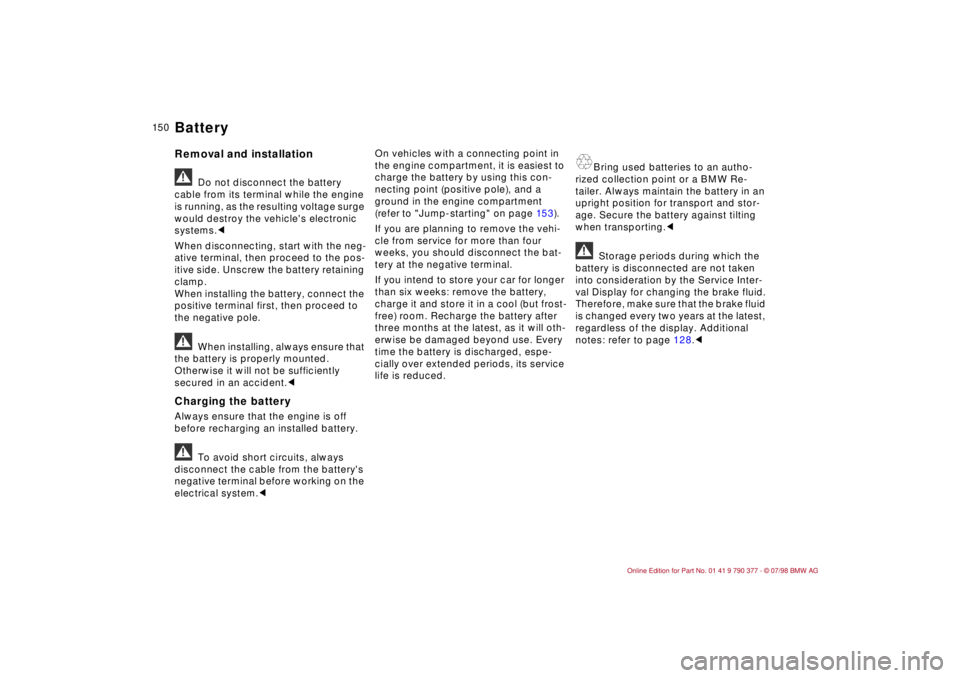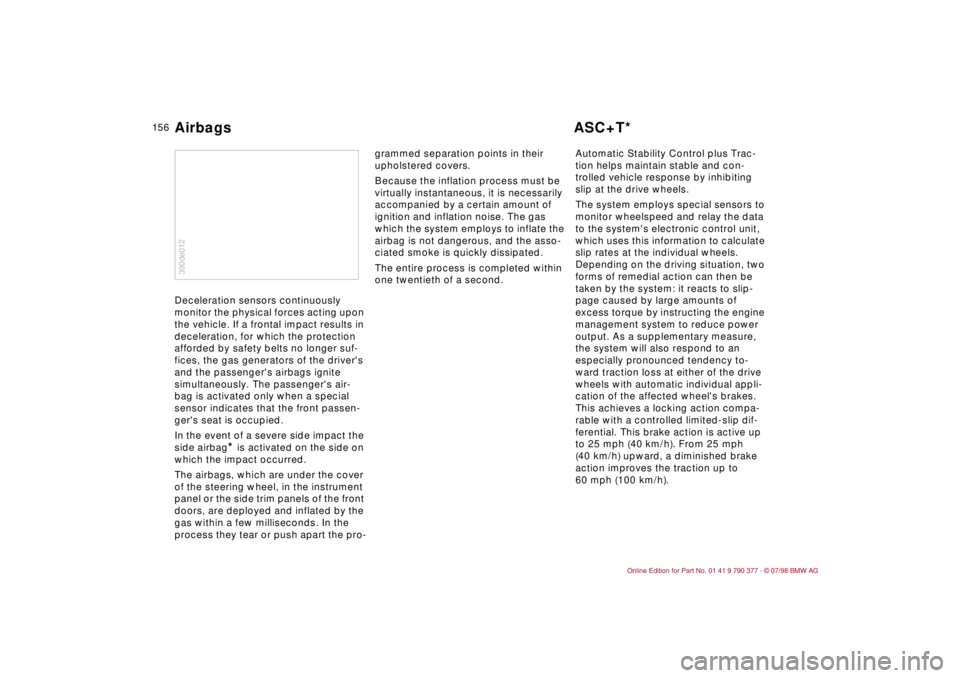1998 BMW CONVERTIBLE ESP
[x] Cancel search: ESPPage 137 of 179

13 6
CareThe appearance and life of the convert-
ible top are highly dependent on its
proper care and operation. You should
pay particular attention to the following
instructions if your care has a light-col-
ored top.
Protect the vehicle from exposure to
intense sunlight whenever possible by
parking it in the shade to prevent the
paint, rubber and fabric-covered parts
from being attacked.
Never fold up the convertible top and
store it in the convertible top compart-
ment when wet, dirty or frozen, as mil-
dew stains and rub spots may result.
To prevent the formation of a fold in the
rear window and mildew stains, do not
leave the top folded up in the convert-
ible top compartment for longer peri-
ods.
If the vehicle is temporarily stored in a
close room, ensure that the top is dry
and provide sufficient ventilation.
Clean off bird droppings immediately,
as they attack the convertible top and
cause the rubber seals to swell due to
their caustic characteristics.Besides water, only treat rubber seals
with talcum powder, rubber care prod-
ucts or silicone spray, particularly when
they feel dry or tend to stick.
Noises, e.g., squeaks, can be elimi-
nated with a lubricant spray.
Never use sharp-edged objects to
clean the rear window of snow and ice.
The use of de-icing spray is not permit-
ted. Due to the danger of damage and
discoloration, do not apply adhesive
tape, stickers etc. to the window or
cover it with plastic film.
The convertible top and its seams may
become leaky as the result of improper
care and cleaning and from the strain of
long use, and depressions and dirt can
result. All warranty claims are void in
these cases. Please take your vehicle to
your BMW Retailer for servicing.
Washing your carYou can wash your BMW Convertible in
automatic car washes. Here preference
should be given to brushless systems.
If a brushless car wash is unavailable
and brush car wash must be used,
modern systems with soft brushes are
preferable. Do not select special wax-
ing programs. The small amount of
beading wax always used in automatic
car washes will not harm your vehicle's
finish.
In the case of more extensive dirt,
which is especially visible on light-col-
ored top materials, clean the top with
the BMW Convertible Cleaning Set.
Please proceed as follows:
Spray the top with the cleaning agent
and then rub with a well-dampened
sponge using circular motions until a
foam develops. Then you can finish
washing the vehicle in an automatic car
wash. After three to five washings the
top should be treated with a special
impregnating spray. Please follow the
instructions on the spray can.
Cleaning and care of the convertible top
Page 139 of 179

13 8
Conduct the following work immedi-
ately prior to storing the vehicle:
1 Activate the parking brake and foot-
brake to dry them; this will prevent
the brake disks and drums from cor-
roding.
2 Store the vehicle in a dry, well-venti-
lated room, shift into reverse gear or
set the selector lever to position P
and chock the wheels to prevent roll-
ing. Do not set the parking brake.
3 Remove the battery, recharge and
store in a cool, frost-free room.
During storage, recharge the battery
every three months, as otherwise it will
become unusable. Every time the bat-
tery is discharged, especially over
extended periods, its service life is
reduced.
Removing vehicle from storageRecharge the battery and replace if
necessary.
Then have Inspection I carried out by
your BMW Retailer.a
Storage periods during which the
battery is disconnected are not taken
into consideration by the Service Inter-
val Display for changing the brake fluid.
Therefore, make sure that the brake fluid
is changed every two years at the latest,
regardless of the display. Additional
notes: refer to page 128.c
Vehicle storage
Page 148 of 179

14 7
At a glanceControlsCar careRepairsTechnicalDataIndex
Procedure1 Wheel bolt cover
* removal.
Steel disk wheel: remove wheel cover
by hand. Light-alloy wheel with lug
cap in the shape of a large hexagon
nut: position the hexagon adapter on
the lug bolt cover, apply the lug
wrench and turn it to the left.2 Loosen lug bolts 1/2 turn.
3 Remove the respective cover cap
from the jacking point. Depending on
the vehicle version, remove the pro-
tective cap either by inserting the
screwdriver into the slot and turning
to the left (arrow in left illustration) or
by pressing in the cap on the bottom
(arrow in illustration above).4 Insert the jack all the way into the
support while ensuring that the base
of the jack is securely positioned on
the road surface. Always chock the
wheels to prevent the vehicle from
rolling.
5 Turn the handle to raise the jack until
the wheel is free of the ground.
a
The vehicle jack is designed for
changing tires only. Never use it to raise
another vehicle model or a load of an-
other kind, since that could result in ac-
cidents and personal injury.
Never lie beneath the vehicle when it is
supported by the jack Ð risk of fatal inju-
ry!c
6 Unscrew the lug bolts and remove the
wheel.
360de108
365de061
360de109
Changing tires
Page 150 of 179

14 9
At a glanceControlsCar careRepairsTechnicalDataIndex
The battery is located behind the right-
side trim panel in the luggage compart-
ment. A separate positive terminal in
the engine compartment is available for
jump-starting (also refer to page 153).
Only certain battery types may be used
on the BMW convertible. Consult your
BMW Retailer for details.
The battery is maintenance-free, mean-
ing that the electrolyte will normally last
for the life of the battery.
Should the electrolyte drop to below
the minimum level - e.g., during extend-
ed operation in hot climates - add dis-
tilled water (no acid!).
Electrolyte level: Up to the "MAX" mark
on the outside of the battery in each
cell, approx. 0.2 inches (5 mm) above
the top of the plates.
Keep the top of the battery clean and
dry.
SymbolsYou will find the following symbols on
your car battery. To avoid injury, please
observe the corresponding precautions
whenever you work with or near the
battery.
360de125
Before working with the battery,
read the following:
R
Wear eye protection. Avoid let-
ting acid or lead particles come
into contact with your eyes, your
skin or your clothing.
S
Battery acid is extremely corro-
sive. Wear eye protection and
protective gloves. Do not tilt the
battery; acid could emerge from the
ventilation openings.
T
Ensure that children keep well
away from batteries and battery
acid.
U
Never allow sparks or open
ßame, and do not smoke in the
vicinity of the battery. Avoid
sparks from electrical cables and
equipment. Never short-circuit the bat-
tery terminals. There is a danger of
injury from powerful sparks.
V
A highly-explosive gas is gener-
ated when the battery is
charged.
W
If you happen to get acid in your
eyes, rinse thoroughly for sev-
eral minutes with clear water.
Then consult a physician immediately. If
you get acid spray on your skin or cloth-
ing, apply soap immediately to neutral-
ize the acid, then rinse with plenty of
water. If electrolyte is accidentally
ingested, consult a physician immedi-
ately.
X
To protect the casing against
ultraviolet radiation, avoid
exposing it to direct sunlight.
A discharged battery can freeze; always
store the battery in areas where the
temperature remains above freezing.
Battery
Page 151 of 179

15 0
Removal and installationa
Do not disconnect the battery
cable from its terminal while the engine
is running, as the resulting voltage surge
would destroy the vehicle's electronic
systems.c
When disconnecting, start with the neg-
ative terminal, then proceed to the pos-
itive side. Unscrew the battery retaining
clamp.
When installing the battery, connect the
positive terminal first, then proceed to
the negative pole.
a
When installing, always ensure that
the battery is properly mounted.
Otherwise it will not be sufficiently
secured in an accident.c
Charging the battery Always ensure that the engine is off
before recharging an installed battery. a
To avoid short circuits, always
disconnect the cable from the battery's
negative terminal before working on the
electrical system.cOn vehicles with a connecting point in
the engine compartment, it is easiest to
charge the battery by using this con-
necting point (positive pole), and a
ground in the engine compartment
(refer to "Jump-starting" on page 15 3).
If you are planning to remove the vehi-
cle from service for more than four
weeks, you should disconnect the bat-
tery at the negative terminal.
If you intend to store your car for longer
than six weeks: remove the battery,
charge it and store it in a cool (but frost-
free) room. Recharge the battery after
three months at the latest, as it will oth-
erwise be damaged beyond use. Every
time the battery is discharged, espe-
cially over extended periods, its service
life is reduced.
A
Bring used batteries to an autho-
rized collection point or a BMW Re-
tailer. Always maintain the battery in an
upright position for transport and stor-
age. Secure the battery against tilting
when transporting.c
a
Storage periods during which the
battery is disconnected are not taken
into consideration by the Service Inter-
val Display for changing the brake fluid.
Therefore, make sure that the brake fluid
is changed every two years at the latest,
regardless of the display. Additional
notes: refer to page 128.c
Battery
Page 152 of 179

15 1
At a glanceControlsCar careRepairsTechnicalDataIndex
If an electrical device fails, switch it off
and check the fuse.
The fuse box (electrical distribution
center) with spare fuses, relays and
plastic tweezers, is located on the left-
hand side of the engine compartment.
dPress the retaining flap in and lift off
the cover.
dRemove the fuse of the defective
consumer from the socket with the
plastic tweezers.
dIf the fuse is burned through (the
metal wire will have melted and sep-
arated), replace it with a new fuse of
the same ampere rating.A list of the fuses with their respective
ampere ratings and the equipment in
their circuits is provided in the fuse box
lid.
a
Do not patch burned out fuses or
replace them with fuses of a different
color or ampere rating, since this could
cause an overload on an electrical wire
and lead to fire in the vehicle.c
If the fuse continues to burn through,
refer the problem to a BMW Retailer for
repair.
360de102Fuses
Page 157 of 179

15 6
Deceleration sensors continuously
monitor the physical forces acting upon
the vehicle. If a frontal impact results in
deceleration, for which the protection
afforded by safety belts no longer suf-
fices, the gas generators of the driver's
and the passenger's airbags ignite
simultaneously. The passenger's air-
bag is activated only when a special
sensor indicates that the front passen-
ger's seat is occupied.
In the event of a severe side impact the
side airbag
* is activated on the side on
which the impact occurred.
The airbags, which are under the cover
of the steering wheel, in the instrument
panel or the side trim panels of the front
doors, are deployed and inflated by the
gas within a few milliseconds. In the
process they tear or push apart the pro-grammed separation points in their
upholstered covers.
Because the inflation process must be
virtually instantaneous, it is necessarily
accompanied by a certain amount of
ignition and inflation noise. The gas
which the system employs to inflate the
airbag is not dangerous, and the asso-
ciated smoke is quickly dissipated.
The entire process is completed within
one twentieth of a second.Automatic Stability Control plus Trac-
tion helps maintain stable and con-
trolled vehicle response by inhibiting
slip at the drive wheels.
The system employs special sensors to
monitor wheelspeed and relay the data
to the system's electronic control unit,
which uses this information to calculate
slip rates at the individual wheels.
Depending on the driving situation, two
forms of remedial action can then be
taken by the system: it reacts to slip-
page caused by large amounts of
excess torque by instructing the engine
management system to reduce power
output. As a supplementary measure,
the system will also respond to an
especially pronounced tendency to-
ward traction loss at either of the drive
wheels with automatic individual appli-
cation of the affected wheel's brakes.
This achieves a locking action compa-
rable with a controlled limited-slip dif-
ferential. This brake action is active up
to 25 mph (40 km/h). From 25 mph
(40 km/h) upward, a diminished brake
action improves the traction up to
60 mph (100 km/h).
390de012Airbags ASC+T*
Page 158 of 179

15 7
At a glanceControls Car careRepairsTechnicalDataIndex
AM provides substantially longer recep-
tion ranges than FM. AM broadcast sig-
nals, propagated at ground level in the
form of surface waves, are also reßected
from the ionosphere as atmospheric
waves.
Frequency-modulation (FM) provides
substantially better sound quality than
AM. However, because FM transmis-
sions rely on line-of-sight broadcast
waves, their effective reception range is
limited. Although numerous factors combine to
impose inherent limitations on the
reception quality available from mobile
radios, specially designed systems can
be employed to minimize their effects:
The Antenna Diversity system employs
several FM antennas integrated within
the rear window to provide three sepa-
rate sources for receiving broadcast
waves. An integral processor automati-
cally selects the antenna with the best
FM reception quality at any given time.
Because the ongoing antenna selection
process is completed within millisec-
onds, it remains inaudible to the radio
listener. The safety belt tensioner responds to
collisions by tightening the belts to
ensure that occupants remain firmly
positioned in their seats. A gas-pres-
sure system retracts the buckle assem-
bly to tension the shoulder and lap belts
within fractions of a second, preventing
the driver and passenger from slipping
forward.360de084
390de108
Radio reception Safety belt tensioner